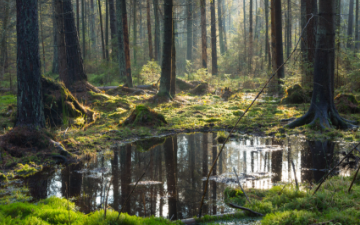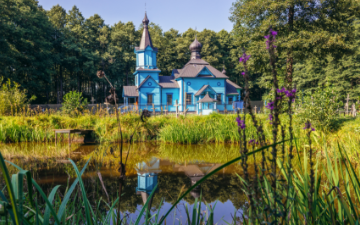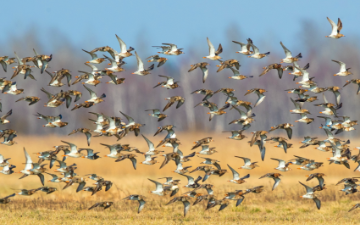











Situated in the north-east of Poland – at the geographical center of Europe – Podlasie is called “the green lungs of Poland”. Anyone looking for an escape from civilization will find it there, in the land of forests and rivers, of which the most important is the River Narew, a “Polish Amazon”. The only of such kind in Europe.
The Podlasie region is among the most interesting in Poland. It’s known for its pristine nature, various cultures coexisting, and old-times vibe.
That’s where you will find beautiful wooden houses, numerous picturesque Orthodox churches, the only Tatar villages in Poland, or the UNESCO-protected Białowieża Forest. The Podlasie region also offers a unique culinary experience so if you are a foodie this area will be a treat for you.
Almost the entire area of the Białowieża Forest has been included in the UNESCO World Heritage List. The Białowieża Forest is the last natural forest ecosystem in Europe with a unique richness of fauna and flora. It is inhabited by wolves, lynxes, otters and the largest European mammals – European bisons. The average age of trees in the forest is 126 years. Białowieża itself offers a number of historic treats, such as the beautiful Palace Park and the former railway station built for Russian Tsar Nicholas II, which now hosts the Carska Restaurant.
The largest national park in Poland covers a vast wetland full of marshes and peat bogs. The Biebrza Valley has retained its natural character and provides habitat for a wealth of bird species, including the remarkable ruff, which proudly flutters its wings in the Biebrza National Park’s logo. Featuring an extensive network of hiking, cycling and kayaking trails, the Park lets you immerse (at times even literally!) in the pristine nature untouched by human hand.
When crossing the Park along the Tsar’s Route, be prepared to meet the mighty elk, majestically strutting around the wetlands.
The Suwałki Landscape Park offers jaw dropping vistas. Its unique landform was created by a glacier 10,000 years ago and features picturesque hills, green valleys and gleaming lakes. Dive into Poland’s deepest lake – Hańcza, soak up stunning views from atop the Cisowa and Zamkowa hills, and marvel at the moonlike landscape of thousands of postglacial boulders scattered around the Bachanowo nature reserve. The Wigry National Park is dotted with tens of dazzling post-glacial lakes. The largest and most impressive of them is Wigry – one of Poland’s purest and most beautiful lakes. With its varied shoreline, numerous islands and bays, Lake Wigry provides habitat for many protected animal species, including a wide range of birds and the Park’s symbol – the beaver. Overlooking the lake is the post-Camaldolese Monastery, a place of extraordinarily mystical ambiance.
Supraśl is a charming and intimate town surrounded by the majestic Knyszyn Forest. It features unique micro climate qualities and is one of the two health resorts in Podlaskie. The town’s historic architecture is in perfect sync with nature. Its present character reflects its long-standing traditions. Relax on the riverfront or get into a kayak to paddle along the Supraśl River. Stroll through the picturesque Wiktor Wołkow Boulevard or dive into the greenery of the Knyszyn Forest, which features a dense network of hiking and cycling trails. Visit the monumental Orthodox Monastery of the Annunciation and the Museum of Icons to marvel at unique pieces of Orthodox sacral art.
Agnieszka Osiecka, a famous Polish poetess and songwriter, used to call Tykocin “a fairy-tale town”. It is a picture-postcard little town with big history which still resounds in its preserved original architecture and Baroque style synagogue. Take your time and stroll at leisure along Tykocin streets to soak up the atmosphere of a traditional Jewish town. Do not miss the Great Synagogue and the Baroque style Holy Trinity Church. Be sure to savour the delicacies of the Jewish cuisine, such as tzimmes, kugel or kreplach, at the Tejsza restaurant just opposite the synagogue.
Tykocin is home to Podlaskie’s only castle. You can stay the night here, and enjoy the flavours of Polish court cuisine.
In the 17th century, King Jan III Sobieski granted the lands around Sokółka and Krynki to the soldiers of the Tartar banners. Their descendants live there to this day, and tourists following the Tartar Trail can learn about their history, culture and delicious cuisine. The most important places along the trail are Kruszyniany and Bohoniki where you can find the oldest mosques in Poland and historic mizars, i.e. cemeteries. The cemeteries in both villages have been recognized as Historical Monuments, which confirms their great importance for the Polish cultural heritage.
Trześcianka, Soce, Puchły – these 3 gorgeous villages in south-eastern part of the region are known as the Land of Open Shutters. They are famous for intricately ornamented wooden houses, stunning colourful Orthodox churches, but most of all for the overwhelming serenity. In many villages in Podlaskie it is still a daily habit for wizened locals to chit-chat sitting on benches in front of their houses. Planning on a longer stay in the Land of Open Shutters? Be sure to pay a visit to neighbouring villages of Plutycze, Ciełuszki, Ploski and Ryboły.